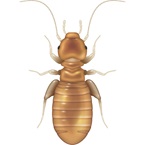Classification
Scientific name: Rhyzopertha Dominica
Family: Bostrichidae
Description
The adults are 2.3-3mm in klength and are dark red brown/back in colour. They have a long, cylindrical body and elytra (hardened wing cases) with well defined rows of punctures. The antennae have usually less than 3 segmented antennal club. The prothorax more of less covers the downward-turned head which is not readily visible from above.
The Lesser Grain Borer originated in South America but is now a cosmopolitan pest especially in warmer countries.
It is not cold hardy pest and development is limited at temperatures less than 23°C. Infestations are typically in grain stores including ships holds, flour mills and animal feed mills. They have also been recorded in woods and books.
Behaviour
In Australia and India, it is a serious pest of grains. Grain borers are associated with a wide variety of vegetable materials including wheat, barley, maize, rice, millet, sorghum, dried potatoes, dried herbs and biscuits.The female lays single or multiple eggs on the outside of the grain but the egg goes through its developmental phases in the hollowed core of the grain.
An infestation is characterised by a sweet yet unpleasant, musty smell from excretions and shed skin.
Risks and Symptoms
Lesser grain borers are primary pests of grain and can attack undamaged grain, rendering it susceptible to attack by secondary pests.
Both the adults and larvae feed on the grain creating a floury dust and potentially, leaving little behind except for the empty husks. The adults are active and may infest a large number of kernels whilst the larvae penetrate kernels and develop within the grain.
They significantly reduce the market value of stored grain.
Life-cycle
The female lesser grain borer lays between 300-500 eggs over a period of approximately three weeks. They are laid singly or in clusters from 2-230 and are often attached to the grain.
Depending upon the temperature the eggs hatch in 7-18 days to give white larvae with brown heads and relatively small legs. These bore into the grains where they feed and develop into the fleshy forms with a typical 'C' shape.
There are up to five moults leading to population in the grain. The pupal stage lasts about one week. The total life-cycle lasts from 24-133 days depending on the temperature.
Adults can live for up to 10 months.

















